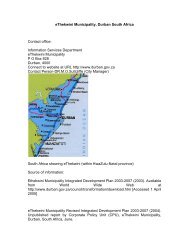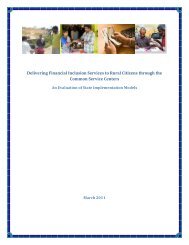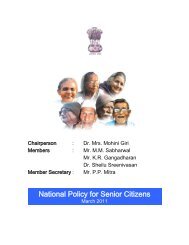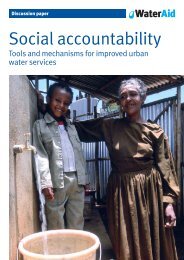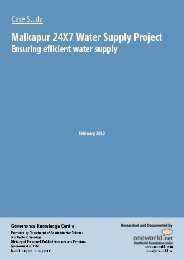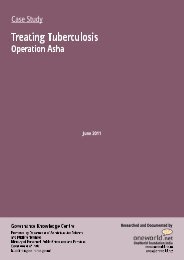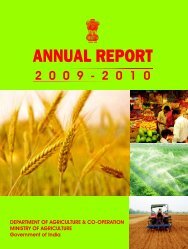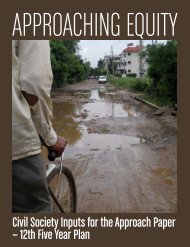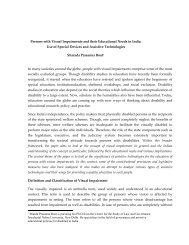Socio Economic & Caste Census 2011 in Rural India - Ministry of ...
Socio Economic & Caste Census 2011 in Rural India - Ministry of ...
Socio Economic & Caste Census 2011 in Rural India - Ministry of ...
You also want an ePaper? Increase the reach of your titles
YUMPU automatically turns print PDFs into web optimized ePapers that Google loves.
xzkeh.k Hkkjr esa lkekftdvkfFkZd ,oa tkfr vk/kkfjrtux.kuk <strong>2011</strong>SOCIO ECONOMIC &CASTE CENSUS <strong>2011</strong>IN RURAL INDIAxzkeh.k fodkl ea=ky;Hkkjr ljdkjM<strong>in</strong>istry <strong>of</strong> <strong>Rural</strong> DevelopmentGOVERNMENT OF INDIA
xzkeh.k Hkkjr esalkekftd vkfFkZd,oa tkfr vk/kkfjrtux.kuk <strong>2011</strong>25 tqykbZ <strong>2011</strong>xzkeh.k fodkl ea=ky;Hkkjr ljdkj1
izLrkoukns”k esa tkfrokj tula[;k ds vuqeku yxkus vkSj xjhch js[kk ls uhps jgus okysifjokjksa dk irk yxkus ds laca/k esa turk dh cgqr vf/kd :fp jgh gSA xjhch js[kkls uhps jgus okys ifjokjksa dk irk yxkus ds fy, fiNyh dk;Zokgh lu~ 2002 esa dh xbZ]ysfdu mldh dbZ lhek,a FkhAvc] xzkeh.k fodkl ea=ky;] Hkkjr ljdkj] twu] <strong>2011</strong> vkSj fnlEcj] <strong>2011</strong> ds chplkekftd] vkfFkZd ,oa tkfr vk/kkfjr tux.kuk ¼,l-bZ-lh-lh½ <strong>2011</strong> dk dk;Z dj jgkgSA igyh ckj Hkkjr ds xzkeh.k vkSj “kgjh nksuksa {ks=ksa ds fy, brus cM+s iSekus ij dk;ZokbZdh tk jgh gSA,l-bZ-lh-lh- <strong>2011</strong> ds fuEufyf[kr rhu mÌs”; gSa%&1. ?kj&?kj tkdj lkekftd&vkfFkZd x.kuk djuk ftlls ifjokjksa dhlkekftd&vkfFkZd fLFkfr ds vk/kkj ij muds Lrj dk irk yx tk,xkArc jkT; ljdkjsa xjhch&js[kk ls uhps jgus okys ifjokjksa dh lwph rS;kj djldsaxhA2. izkekf.kd lwpuk miyC/k djkuk] ftlls ns”k dh tkfrokj tula[;k dh x.kuk gksldsA3. f<strong>of</strong>HkUu tkfr;ksa dh lkekftd&vkfFkZd fLFkfr vkSj f<strong>of</strong>HkUu tkfr;ksa vkSj tula[;k dsf<strong>of</strong>HkUu oxksZa dh “kS{kf.kd fLFkfr ds laca/k esa izkekf.kd lwpuk miyC/k djkukA2002 ds ch-ih-,y- losZ{k.k dh dfe;ksa ij ,l-bZ-lh-lh- <strong>2011</strong> esa foLr`r :i ls /;kufn;k tk jgk gSA ,l-bZ-lh-lh- <strong>2011</strong> esa%& lkjk dk;Z fcuk dkxt&i= ds gS.MgsYM bysDVªksfud fMokbt+¼VscysV ih-lh-½ ij fd;k tk,xkA blls vkadM+k izf<strong>of</strong>’V esa xyfr;k¡ vkSjizx.kd ds L<strong>of</strong>u.kZ; esa cgqr vf/kd deh vk,xhA lkjh lwpuk iw.kZr% vk/kkj vkSj ,u-ih-vkj ds vuqdwy gksxhA2
;g lqfuf”pr~ djus ds fy, fd fdlh izdkj dh xyr lwpuk u nh tk,]x.kuk pj.k ls xzke lHkk ds Lrj ij turk }kjk tk¡p& lHkh Lrjksa ij tk¡piM+rky dh O;oLFkk dh xbZ gSA vf/kdka”k tkudkjh lkoZtfud :i ls miyC/k djk;h tk,xhAbl iqfLrdk esa ,l-bZ-lh-lh- <strong>2011</strong> dks <strong>of</strong>.kZr fd;k x;k gSA pw¡fd] ;g xzkeh.k Hkkjr lslacaf/kr gS] vr% blesa lk/kkj.k Hkk’kk esa iwjh dk;Zokgh fufnZ’V dh xbZ gSAt;jke jes”k t;jke jes”kxzkeh.k fodkl ea=hHkkjr ljdkj3
izk;% iwNs tkus okys iz”u1. lkekftd vkfFkZd ,oa tkfr vk/kkfjr tux.kuk <strong>2011</strong> D;k gS\Hkkjr ljdkj }kjk ns”k Hkj ds ifjokjksa ls lacaf/kr lkekftd vkfFkZd ladsrdksa dh fo”kkyla[;k ij tkudkjh ,d= djus ds fy, lkekftd vkfFkZd ,oa tkfr vk/kkfjr tux.kuk<strong>2011</strong> djkbZ tk jgh gSA blds rhu egRoiw.kZ ifj.kke gkasxs% igyk] lkekftd vkfFkZd ,oa tkfr vk/kkfjr tux.kuk <strong>2011</strong> ifjokjksa dksmudh lkekftd vkfFkZd fLFkfr ds vk/kkj ij jSad iznku djsxh ftllsjkT;@la?k jkT;{ks= ljdkjsa ;FkkFkZ :i ls xzkeh.k rFkk “kgjh {ks=ksa esa xjhch js[kk lsuhps jg jgs ifjokjksa dh ,d lwph rS;kj dj ldsxhA nwljk] blls ns”k esa tula[;k ds tkfrokj C;ksjksa dh izekf.kd tkudkjh miyC/k gksldsxhA rhljk] ;g f<strong>of</strong>HkUu tkfr;ksa dk lkekftd vkfFkZd fooj.k iznku djsxhAlkekftd vkfFkZd ,oa tkfr vk/kkfjr tux.kuk <strong>2011</strong> Hkkjr ljdkj ds rduhdh rFkk foRrh;lg;ksx ds lkFk jkT; ljdkj rFkk la?k jkT;{ks= iz”kklu }kjk xzkeh.k rFkk “kgjh {ks=ksa dsfy, ,d lkFk vk;ksftr dh tk jgh gSA2. lkekftd vkfFkZd ,oa tkfr vk/kkfjr tux.kuk <strong>2011</strong> D;ksa djkbZ tk jghgS\ lkekftd vkfFkZd ,oa tkfr vk/kkfjr tux.kuk <strong>2011</strong> ifjokjkas dks mudh lkekftdvkfFkZd fLFkfr ds vk/kkj ij ;FkkFkZr% ls jSad iznku djsxh tks fd xjhch dh js[kk lsuhps jg jgs ifjokjksa dh igpku dk vk/kkj gksxkA4
lls ljdkjh ;kstukvksa dks lgh ykHkkFkhZ rd igq¡pkus esa lgk;rk feysxh vkSj ;glqfuf”pr gksxk fd lHkh lqik= ykHkkfFkZ;ksa dks ykHk igq¡ps rFkk vik= ykHkkFkhZ budk ykHkugha ys ik,aA vR;f/kd oafpr ds :i esa igpkus x, ifjokjksa dks ljdkjh dY;k.k ;kstukvksa ds varxZrlokZf/kd izkFkfedrk ds lkFk “kkfey fd;k tk,xkA xjhch js[kk ls uhps jg jgs yksxksa dh igpku dk dk;Z fiNyh ckj lu~ 2002 esa fd;kx;k FkkA blls feyh lh[k ds vk/kkj ij dk;Z i)fr dks O;kid :i ls la”kksf/krfd;k x;k rkfd lEiw.kZ dojst] lqfuf”pr ikjnf”kZrk vkSj lkekftd vkfFkZd iSekuksa dsvk/kkj ij ifjokjksa dh igpku dk mÌs”; izkIr fd;k tk ldsA3. lkekftd vkfFkZd ,oa tkfr vk/kkfjr tux.kuk <strong>2011</strong> dc izkjaHk gksxh\ lkekftd vkfFkZd ,oa tkfr vk/kkfjr tux.kuk] twu] <strong>2011</strong> vkSj 31 fnlEcj] <strong>2011</strong>ds e/; vk;ksftr dh tk jgh gSA bls 29 twu] <strong>2011</strong> dks if”peh f=iqjk ds gktheksjk [kaM esa “kq: fd;k x;k Fkk4. lkekftd vkfFkZd ,oa tkfr vk/kkfjr tux.kuk <strong>2011</strong> vkSj ;kstuk vk;ksx}kjk yxk, x, xjhch vuqekuksa esa D;k vraj gS\;kstuk vk;ksx f<strong>of</strong>HkUu jkT;ksa@la?k jkT;{ks=ksa esa xjhch js[kk ls uhps jg jgh xzkeh.k rFkk “kgjhtula[;k dh izfr”krrk ds vuqeku miyC/k djkrk gSA vFkkZr~ ;g vuqeku yxkrk gS fdxjhch “fdruh” gSA nwljh vksj lkekftd vkfFkZd ,oa tkfr vk/kkfjr tux.kuk <strong>2011</strong> ;gtkudkjh iznku djsxh fd “dkSu” lh tula[;k xjhch js[kk ls uhps jg jgh gSA bl izdkjmnkgj.k ds fy,] fdlh jkT; ds laca/k esa ;kstuk vk;ksx ds tula[;k ds xjhch dh js[kk lsuhps jg jgs vuqeku xzkeh.k tula[;k ds fy, 55% vkSj “kgjh tula[;k ds fy, 30% gksldrs gSaA lkekftd vkfFkZd ,oa tkfr vk/kkfjr tux.kuk <strong>2011</strong> ;g igpku djus esa leFkZcuk;sxh fd fdlh f<strong>of</strong>”k’V jkT; esa dkSu ls ifjokj Øe”k% 55% vkSj 30% esa “kkfey gSaA5
ds nkSjku rS;kj ekufp= rFkk laf{kIr edkulwph dh izfr;ka miyC/k djkbZ tk,axhA blls{ks= dk lEiw.kZ dojst lqfuf”pr gksxkA lkekftd vkfFkZd ,oa tkfr vk/kkfjr tux.kuk <strong>2011</strong> ds fy, izx.kdksa dks izf”kf{krfd;k tk,xkA izR;sd izx.kd dks pkj x.kuk CykWd fn, tk,axs vkSj izR;sd 6 izx.kdksa ij ,d i;Zos{kdgksxkA izx.kd x.kuk CykWd esa vfHkKkr izR;sd ifjokj dk nkSjk djsxk vkSj iz”ukoyh dks HkjsxkAos cs?kj tula[;k ¼mnkgj.kkFkZ jsyos LVs”ku] lM+d ds fdukjs] vkfn LFkkuksa ij jg jgsyksx½ ds ikl Hkh tk,axsA izR;sd izx.kd ds lkFk ,d MkVk ,UVªh vkWijsVj jgsxkA ;g MkVk ,d bysDVªkfud gSUM gsYM fMokbl ¼,d VscysV ihlh½ esalh/ks fy;k tk,xkA gSUM gsYM fMokbl esa jk’Vªh; tula[;k jftLVj gsrq Hkjs x, QkeksZadh LdSu best izfo’V gksaxhA blls Hkh lEiw.kZ rFkk ;Fks’V dojst lqfuf”pr~ gksxhA tkudkjh ¼VscysV ihlh esa lekfo’V½ mÙkjnkrk dks i
7. ;g izfØ;k xzkeh.k {ks=ksa esa fdl izdkj vH;kl esa ykbZ tk,sxh\izx.kd x.kuk CykWd ds izR;sd ifjokj ls iz”u iwNukx.kuk CykWd ds vkadM+kas dks ,d= djuklkekftd vkfFkZd ekudksa ds vk/kkj ij Lor% gh lwph ls gVk, tkus okys ifjokjksa dhigpku dh tk ldsxhlkekftd vkfFkZd ekudksa ds vk/kkj ij Lor% gh lwph esa “kkfey fd, tkus okys ifjokjksadh igpku dh tk ldsxh“ks’k ifjokjksa ds oapu dk ewY;kadu djukLor% “kkfey gksus vkSj oapd dkjdksa ds vk/kkj ij ifjokjksa dks jSad nsukjkT; Lrjh; jSafdx rS;kj djukjSafdx fyLV dks jkT; ljdkjksa dks lkSaiukN=d ds :i esa jkT; ljdkjksa }kjk ;kstuk vk;ksx ds xjhch ds vuqekuksa dk mi;ksx8
8. xzkeh.k {ks=ksa esa ifjokjksa dks fdl izdkj jSad fn;k tk,xk\ifjokjksa dks rhu Lrjh; izfØ;k }kjk jSad fn;k tk,xka. ifjokjksa dk ,d lewg Lor% vyx gks tk,xkfuEufyf[kr esa ls cus fdlh Hkh ,d ds /kkjd ifjokj Lor% vyx gks tk;saxsa%eksVj pkfyr nksifg;k@frifg;k@pkj ifg;ksa okys okgu@eNyh idM+us dh ukoAe”khu pkfyr rhu@pkj ifg;ksa okys —f’k midj.kA50 gtkj vkSj blls vf/kd dh ekud lhek ds fdlku ØsfMV dkMZAljdkjh lsod okys fdlh lnL; ds ifjokjAljdkj esa iath—r xSj&—f’k m|ksx okys ifjokjAifjokj dk dksbZ lnL; 10,000 :i, izfr ekl ls vf/kd dekrk gSAvk;dj vnk djrs gSaAO;kolkf;d dj vnk djrs gSAlHkh dejksa esa iDdh nhokjsa vkSj Nr ds lkFk rhu vFkok vf/kd dejsAjsfQztjsVj gSAySaMykbu Qksu gSAde ls de 1 flapkbZ midj.k ds lkFk 2.5 ,dM+ vFkok blls vf/kd flafpr Hkwfe gSAnks vFkok mlls vf/kd Qly ds ekSle ds fy, 5 ,dM+ vFkok blls vf/kd flafpr Hkwfe gSAde ls de ,d flapkbZ midj.k ds lkFk de ls de 7.5 ,dM+ vFkok blls vf/kd Hkwfe gSAb. ifjokjksa dk ,d lewg Lor% 'kkfey gks tk,xkfuEufyf[kr fLFkfr okyk ifjokj Lor% 'kkfey gks tk;sxk%cs?kj ifjokjfujkfJr@fHk{kqdeSyk
c- ckdh cps ifjokjksa dks lkr oapu lwpdkadks dk iz;ksx djrs gq, jSad fn;k tk,xkAlcls vf/kd oapu Ldksj okys ifjokj dks xjhch js[kk ls uhps okys ifjokjksa dh lwphesa 'kkfey djus ds fy, lcls mPp izkFkfedrk nh tk,xhAfuEufyf[kr oapu lwpdkad gSa% dPph nhokjksa vkSj dPph Nr ds lkFk dsoy ,d dejs esa jgus okys ifjokjA ifjokj esa 16 ls 59 o’kZ ds chp dh vk;q dk dksbZ o;Ld lnL; ugha gSA efgyk eqf[k;k okys ifjokj ftlesa 16 ls 59 o’kZ ds chp dh vk;q dk dksbZ o;Ld iq:’klnL; ugha gSA fu%”kDr lnL; okys vkSj fdlh l{ke “kjhj okys o;Ld lnL; ls jfgr ifjokjA vuq-tk-@vuq-t-tk- ifjokj ,sls ifjokj tgka 25 o’kZ ls vf/kd vk;q dk dksbZ o;Ld lk{kj ugha gSA Hkwfeghu ifjokj tks viuh T;knkrj dekbZ fngkM+h etnwjh ls izkIr djrs gSaA9. xzkeh.k {ks=ksa esa tkudkjh dkSu ,df=r djsxk\ izR;sd x.kuk CykWd esa jkT; ljdkj }kjk fu;qDr izx.kd ;g dk;Z djsxkA mlds lkFk,d MkVk ,aVªh vkijsVj gksxkA izx.kd vius lkFk jkT; izkf/kdkjh }kjk tkjh viuk fu;qfDr izek.k&i= vkSj igpkui= ysdj vk,xkA blds vykok] O;fDrxr foosdkf/kdkj dh dksbZ laHkkouk u NksM+rs gq,izx.kd ds lkFk xzke iapk;r] xzke lHkk dk izfrfuf/k vkSj dksbZ vU; ukxfjd gks ldrkgS rkfd vkadM+s fu’i{k vkSj ikjn”khZ rjhds ls ,df=r fd;s tkus lqfuf”pr~ gksaA ;g /;ku nsa fd f”k{kk dk vf/kdkj vf/kfu;e] 2009 }kjk izfrca/k yxk;s tkus ds dkj.kbl iz;kstu ds fy, izkFkfed fo|ky; f”k{kdksa dh lsok;sa izkIr ugha dh tk ldrh gSaA10
10. tkudkjh fdl izdkj ,df=r dh tk,xh\ izx.kd vius ikl j[kh iz”ukoyh esa ls mÙkjnkrk ls iz”u iwNsxkA MkVk ,aVªh vkijsVjmu mÙkjksa dks gLrpkfyr bySDVªkfud midj.k ¼VscysV ih-lh-½ esa ntZ djsxkA mÙkjnkrk dks vius }kjk nh tk jgh tkudkjh ds leFkZu esa dksbZ nLrkost+h lk{; ughafn[kkuk gSA rFkkfi] mÙkjnkrk ls ;g vis{kk dh tkrh gS fd og lgh vkSj izekf.kdtkudkjh ns ftldk izx.kd }kjk lR;kiu fd;k tk ldrk gSA vkadM+s ,d=.k dk dk;Z iwjk gks tkus ds ckn izx.kd vius vkSj MkVk ,UVªh vkijsVj}kjk gLrk{kfjr ikorh jlhn mÙkjnkrk dks nsxkA izx.kd mÙkjnkrk ds edku dh ckgjh nhokj ij LVhdj fpidk;sxkA11. xzkeh.k {ks=ksa esa fdl rjg dh tkudkjh ,df=r dh tk,xh\tkudkjh O;fDr vkSj ifjokj ds lanHkZ esa ,df=r dh tk,xh ftlesa fuEufyf[kr “kkfeygS%& O;olk; f”k{kk fu%”kDrrk /keZ vuq-tk-@vuq-t-tk- fLFkfr tkfr@tutkfr dk uke jkst+xkj vk; vkSj vk; dk lk/ku ifjlEifÙk;k¡ edku fVdkÅ vkSj xSj&fVdkÅ miHkksDrk lkeku Hkwfe11
12. xzkeh.k {ks=ksa esa dkSu ls vkadM+s miyC/k djk;s tk;saxs vkSj dgk¡ ij\elkSnk izdk”ku lwph dk eqnz.k djus ds i”pkr~ ifjokj }kjk vius /keZ vkSj tkfr ds ukeds ckjs esa nh xbZ tkudkjh dks NksM+dj vU; lHkh vkadM+s] xzkelHkk vkSj iapk;r esa i
EklkSnk lwph ds izdk”ku ds ,d lIrkg ds Hkhrj xzke lHkk dh cSBd dh tk,xhA xzkelHkk dh cSBd esa izR;sd ifjokj ds uke vkSj mÙkj Ik
lkekftd vkfFkZd ,oa tkfr vk/kkfjr tux.kuk ¼,l-bZ-lh-lh-½ <strong>2011</strong>] ] ch-ih-,y tux.kuk 2002 ls fdl izdkj csgrj gS\1. mi;ksx esa yk,x, ek<strong>in</strong>.M2. vkdM+ks dklR;kiu vkSj turk}kjk tkapch-ih-,y- 2002 ,l-bZ-lh-lh- <strong>2011</strong> ch-ih-,y- 2002 ds lUnHkZ esyk, x, uokpkj13 lkekftd&vkfFkZdlwpdkadks ds lkFk igpkuhxbZ ch-ih-,y- tula[;kds ifj.kkeksa esa =qfV;ksa dkcgqr vf/kd lfEeyu vkSjviotZu jgkAtkudkjh dks turk lslR;kfir ugha djk;k x;kA3. Ldksj i)fr 52 fcUnqvksa dh tfVyi)fr4. eSuqvy cukebySDVªksfud5. ,df=r vkadM+ksdh mi;ksfxrk6. tux.kuk dkizdkjvkdM+ksa dh izf<strong>of</strong>’V NisQkeksZa ls gkFk ls dh xbZdk;ZØe dh e/;LFkrk gsrqf<strong>of</strong>HkUu ea=ky;ksa dks vkadM+smiyC/k ugha djk, x,2002 dk ch- ih- ,y-,dy :Ik esa fd;k x;kch-ih-,y- tula[;k dksigpkuus okys ds fy,mi;ksx esa yk;s tk jgsekun.M ds 3 ?kVd gS%Lor% viotZuLor% lfEeyu vkSj lkroapu lwpdkadksa ds vk/kkjij jSfdaxAx.kuk Lrj ij i;Zos{kd]xzke lHkk vkSj jkT;ljdkj ds vU; dk;kZy;ksa}kjk lR;kiuvklku i)fr ds lkFkoxhZdj.k ds 4 rjhdsgSaMgsYM bysDVªksfud fMokbZl¼VscysV ih-lh-½ ls vkdM+ksadh lh/kh izf<strong>of</strong>’VvkadM+ks dk ,e- vkbZ-,l- esa izn”kZu] vk/kkj ,oa,u- ih- vkj- ds lkFkiwjh rjg vuqdqy] f<strong>of</strong>HkUuea=ky;ksa] jkT;ksa] ih- vkjvkbZ-,oa ukxfjdksa dsmi;ksx ds fy, lqyHk,l- bZ- lh- lh- <strong>2011</strong>xzkeh.k ,oa uxjh; {ks=ksa dsfy, la;qDr :i ls tkfrdh x.kuk ds lkaFk fd;k tkjgk gSAlfEeyu@viotZu dh lhek js[kkdks dkQh gn rd de dj fn;kx;k gS% Lor% viotZu dk ekun.Mvik= ifjokjksa ds ch-ih-,y- lwph esa izos”k ikus dhlEHkkouk dks de djrk gSA Lor% lfEeyu dk ekun.Mlcls ik= ifjokjksa ds ch-ih-,y- lwph esa “kkfey gksus dhlEHkkouk dks cldrs gS%vklkuh ls dk;kZfUor fd;k tkldrk gS vklkuh ls lR;kiu]izx.kd dh viuh le> dk debLrseky] ch-ih-,ytux.kuk2002 esa iz;ksx esa yk,x, f<strong>of</strong>”k’Vlqfo/kkvksa ¼tSls “kkSpky; bR;kfn ½vk/kkfjr ekun.M dk mi;ksx ughafd;k tkrkAdkxt&eqDr i)fr n{krk c
lkekftd&vkfFkZd ,oa tkfr vk/kkfjr tux.kuk <strong>2011</strong>ds fy, Hkkjr bySDVªkWfuDl fyfeVsM}kjk fodflr y?kq gLrpkfyr midj.k ¼ih-lh-½eq[; fo”ks’krk,¡ izHkkoh x.kuk dk lk/ku rFkk miyC/k midj.k bldk otu 1 fd-xzk- gS rFkk bls gLrpkfyr midj.k ds :i esa dgha Hkhys tk;k tk ldrk gS 7 bap ,y-lh-Mh- jaxhu fMLIys Vp LØhu] usfoxs”ku&dh rFkk dh&cksMZ bZFkjusV ds ek/;e ls baVjusV laidZrk] 2 ;w-,l-ch- iksVZ blds f<strong>of</strong>o/k dk;ksZa esa lksyj cSVjh dk mi;ksx fd;k tk ldrk gSA15
SOCIOECONOMIC &CASTE CENSUS<strong>2011</strong>IN RURAL INDIA25 th July <strong>2011</strong>M<strong>in</strong>istry <strong>of</strong> <strong>Rural</strong> DevelopmentGOVERNMENT OF INDIA17
ForewordThere has been extensive public <strong>in</strong>terest <strong>in</strong> estimat<strong>in</strong>g caste-wisepopulation <strong>in</strong> the country, and on identify<strong>in</strong>g households liv<strong>in</strong>gbelow the poverty l<strong>in</strong>e. The last exercise to identify people liv<strong>in</strong>g <strong>in</strong>poverty was conducted <strong>in</strong> 2002, but had several limitations.The M<strong>in</strong>istry <strong>of</strong> <strong>Rural</strong> Development Government <strong>of</strong> <strong>India</strong>, is nowcarry<strong>in</strong>g out the <strong>Socio</strong> <strong>Economic</strong> and <strong>Caste</strong> <strong>Census</strong> (SECC) <strong>2011</strong>,between June <strong>2011</strong> and December <strong>2011</strong>, through a comprehensivedoor to door enumeration across the country. This is the first timesuch a comprehensive exercise is be<strong>in</strong>g carried out for both ruraland urban <strong>India</strong>.The SECC, <strong>2011</strong> has the follow<strong>in</strong>g three objectives:1. To enable households to be ranked based on their socioeconomicstatus. State Governments can then prepare a list <strong>of</strong>families liv<strong>in</strong>g below the poverty l<strong>in</strong>e2. To make available authentic <strong>in</strong>formation that will enable castewisepopulation enumeration <strong>of</strong> the country3. To make available authentic <strong>in</strong>formation regard<strong>in</strong>g the socioeconomiccondition, and education status <strong>of</strong> various castes andsections <strong>of</strong> the populationThe shortcom<strong>in</strong>gs <strong>of</strong> the 2002 BPL survey are be<strong>in</strong>g addressedcomprehensively <strong>in</strong> the SECC, <strong>2011</strong>: The entire exercise will be paperless, done on a handheldelectronic device (tablet PC). This will drastically reduce dataentry errors and enumerator discretion18
Checks and balances at several levels - from the enumerationstage, to public scrut<strong>in</strong>y at the Gram Sabha level – will ensurethat there is no misreport<strong>in</strong>gAlmost all <strong>of</strong> the <strong>in</strong>formation will be made available <strong>in</strong> the publicdoma<strong>in</strong>This booklet expla<strong>in</strong>s the SECC,<strong>2011</strong>, as it relates to rural <strong>India</strong>,and details the entire process <strong>in</strong> simple languageJairam RameshM<strong>in</strong>ister <strong>of</strong> <strong>Rural</strong> DevelopmentGovernment <strong>of</strong> <strong>India</strong>19
Frequently Asked Questions(FAQs)1. What is the <strong>Socio</strong> <strong>Economic</strong> and <strong>Caste</strong> <strong>Census</strong>(SECC) <strong>2011</strong>?The <strong>Socio</strong> <strong>Economic</strong> and <strong>Caste</strong> <strong>Census</strong> (SECC), <strong>2011</strong> is be<strong>in</strong>g carriedout by the Government <strong>of</strong> <strong>India</strong> to generate <strong>in</strong>formation on a largenumber <strong>of</strong> social and economic <strong>in</strong>dicators relat<strong>in</strong>g to householdsacross the country. It will have three important outcomes: Firstly, the SECC, <strong>2011</strong> will rank households based on their socioeconomicstatus, so that State/Union Territory Governmentscan objectively prepare a list <strong>of</strong> families liv<strong>in</strong>g below the povertyl<strong>in</strong>e <strong>in</strong> rural and urban areas Secondly, it will make available authentic <strong>in</strong>formation on thecaste-wise breakup <strong>of</strong> population <strong>in</strong> the country Thirdly, it will provide the socio-economic pr<strong>of</strong>ile <strong>of</strong> variouscastesThe SECC, <strong>2011</strong> is be<strong>in</strong>g conducted simultaneously for ruraland urban areas, by the respective State Government and UnionTerritory Adm<strong>in</strong>istration, with technical and f<strong>in</strong>ancial support fromthe Government <strong>of</strong> <strong>India</strong>.2. Why is the SECC, <strong>2011</strong> be<strong>in</strong>g carried out? The SECC, <strong>2011</strong> will objectively rank households based ontheir socio-economic status, which would be the basis foridentification <strong>of</strong> households liv<strong>in</strong>g below the poverty l<strong>in</strong>e20
This exercise will help to better target government schemes tothe right beneficiaries, and ensure that all eligible beneficiariesare covered, while all <strong>in</strong>eligible beneficiaries are excluded Households identified as highly deprived will have the highest<strong>in</strong>clusion priority under Government welfare schemes The last exercise to identify people liv<strong>in</strong>g below the poverty l<strong>in</strong>ewas conducted <strong>in</strong> 2002. Based on the learn<strong>in</strong>g from this exercisethe methodology has been comprehensively revised to ensurecomplete coverage, transparency and objective identification <strong>of</strong>households based on socio economic parameters.3. When will the SECC, <strong>2011</strong> take place? The SECC, <strong>2011</strong> is be<strong>in</strong>g conducted between June <strong>2011</strong> and 31 stDecember <strong>2011</strong> It was launched on 29 th June <strong>2011</strong> <strong>in</strong> Hazemora Block <strong>in</strong> WestTripura4. What is the difference between SECC, <strong>2011</strong> and thePlann<strong>in</strong>g Commission estimates <strong>of</strong> poverty?The Plann<strong>in</strong>g Commission provides estimates <strong>of</strong> the percentage<strong>of</strong> the rural and urban population liv<strong>in</strong>g below the poverty l<strong>in</strong>e <strong>in</strong>different States/UTs. That is, it estimates the “how much” <strong>of</strong> poverty.The SECC, <strong>2011</strong> on the other hand, will provide <strong>in</strong>formation on the“who” <strong>of</strong> the population liv<strong>in</strong>g below the poverty l<strong>in</strong>e. Thus, forexample, the Plann<strong>in</strong>g Commission estimate for a State couldbe that say 55% <strong>of</strong> the rural population and say 30% <strong>of</strong> the urbanpopulation is liv<strong>in</strong>g below the poverty l<strong>in</strong>e. SECC, <strong>2011</strong> will enablethat particular State to identify the households who comprise this55% and 30% respectively.21
5. Has the SECC, <strong>2011</strong> methodology been pilottested?<strong>Rural</strong> areas: The methodology for rural areas has beenf<strong>in</strong>alized after field test<strong>in</strong>g several methodologies; and us<strong>in</strong>g therecommendations <strong>of</strong> the Saxena Expert Group as the referencepo<strong>in</strong>t. The field test<strong>in</strong>g was carried out <strong>in</strong> two stages. First, asocio-economic census <strong>of</strong> 254 villages was conducted us<strong>in</strong>g astructured questionnaire. Second, a participatory rural appraisal(PRA) technique was used to rank households <strong>in</strong> the same villageaccord<strong>in</strong>g to several well-be<strong>in</strong>g criteria. The results <strong>of</strong> 161 villagesspread over 29 states, cover<strong>in</strong>g 43,000 rural households have beenused to f<strong>in</strong>alize the criteria used <strong>in</strong> the SECC, <strong>2011</strong> for rural areas.Urban areas: The Plann<strong>in</strong>g Commission appo<strong>in</strong>ted the HashimCommittee Expert Group to identify the methodology to conductthe SECC <strong>in</strong> urban areas. The data generated will be analyzed, andon the basis <strong>of</strong> this, the Committee will determ<strong>in</strong>e the methodologyfor identification <strong>of</strong> poor households <strong>in</strong> urban areas.6. What is the process <strong>of</strong> conduct<strong>in</strong>g the SECC, <strong>2011</strong><strong>in</strong> rural areas?The SECC, <strong>2011</strong> will be conducted through a comprehensiveprogramme <strong>in</strong>volv<strong>in</strong>g the M<strong>in</strong>istry <strong>of</strong> <strong>Rural</strong> Development, M<strong>in</strong>istry<strong>of</strong> Hous<strong>in</strong>g and Urban Poverty Alleviation, The Office <strong>of</strong> theRegistrar General and <strong>Census</strong> Commissioner, <strong>India</strong> and the StateGovernments. The process is as follows: Each Collector/District Magistrate will formulate a District/Town Plan and a Communication Plan 24 lakh Enumeration Blocks (EB) will be used for the SECC, <strong>2011</strong>- each Enumeration Block has roughly 125 households. Theseare the same Enumeration Blocks that were formed dur<strong>in</strong>g the<strong>Census</strong> <strong>2011</strong>. The enumerators will be provided copies <strong>of</strong> thelayout maps and Abridged House List prepared dur<strong>in</strong>g <strong>Census</strong>22
<strong>2011</strong>. This will ensure complete coverage <strong>of</strong> the area. Enumerators will be tra<strong>in</strong>ed to conduct the SECC, <strong>2011</strong> Each Enumerator will be assigned 4 Enumeration Blocks, andevery 6 Enumerators will be assigned to one Supervisor Enumerators will visit every household identified <strong>in</strong> theEnumeration Block and canvas the questionnaire. They will alsoreach out to homeless populations (eg. people liv<strong>in</strong>g <strong>in</strong> railwaystations, roadsides etc) A data entry operator will accompany each Enumerator The data will be captured directly on an electronic handhelddevice (a tablet PC). The hand held device will have the scannedimages <strong>of</strong> the forms filled up for National Population Register(NPR). This will also ensure complete and accurate coverage The <strong>in</strong>formation (held <strong>in</strong> the tablet PC) will be read out to therespondent, who will verify it. A pr<strong>in</strong>ted acknowledgement slip,signed by the Enumerator and Data Entry Operator will be givento the respondent Collected data will be verified <strong>in</strong> the Panchayat After all the <strong>in</strong>formation is collected from an EnumerationBlock, a draft publication list will be prepared for verification With<strong>in</strong> a week <strong>of</strong> publication <strong>of</strong> the draft list, the list will be readout at the Gram Sabha <strong>in</strong> all rural areas Any person can file claims/objections and <strong>in</strong>formation furnishedbefore designated <strong>of</strong>ficers for this purpose. The draft list willbe made available at the Gram Panchayat, Block DevelopmentOffice, Charge Centre and District Collector’s Offices The list will also be uploaded on the NIC/State Government/MoRD/MoHUPA websites. This will aid transparency and<strong>in</strong>crease accountability23
7. How will the process work <strong>in</strong> practice?Enumerator will canvass questions <strong>in</strong> each household <strong>in</strong> anEnumeration BlockAggregation <strong>of</strong> Enumeration Block dataBased on the socio economic parameters, households that will beautomatically excluded will be identifiedBased on the socio economic parameters, households that will beautomatically <strong>in</strong>cluded will be identifiedAssess deprivation <strong>of</strong> rema<strong>in</strong><strong>in</strong>g householdsRank households on the basis <strong>of</strong> automatic <strong>in</strong>clusion anddeprivation <strong>in</strong>dicatorsPreparation <strong>of</strong> State Level Rank<strong>in</strong>gRank<strong>in</strong>g list to be handed over to State GovernmentsState Governments to use Plann<strong>in</strong>g Commission poverty estimatesas a cap24
8. How will the households be ranked <strong>in</strong> ruralareas?Households will be ranked through a three-step process.a. A set <strong>of</strong> households will be automatically EXCLUDEDA household with any <strong>of</strong> the follow<strong>in</strong>g will be excludedautomatically: Motorized two/three/four wheeler/ fish<strong>in</strong>g boat/Mechanized three/four wheeler agricultural equipmentKisan Credit Card with credit limit <strong>of</strong> Rs. 50,000 and aboveHousehold with any member as a Government employeeHouseholds with non-agricultural enterprises registered with theGovernmentAny member <strong>of</strong> the family earn<strong>in</strong>g more than Rs. 10,000 per monthPay<strong>in</strong>g <strong>in</strong>come taxPay<strong>in</strong>g pr<strong>of</strong>essional taxThree or more rooms with all rooms hav<strong>in</strong>g pucca walls and ro<strong>of</strong>Own a refrigeratorOwn Landl<strong>in</strong>e phoneOwn 2.5 acres or more <strong>of</strong> irrigated land with at least 1 irrigationequipment5 acres or more <strong>of</strong> irrigated land for two or more crop seasonsOwn<strong>in</strong>g at least 7.5 acres <strong>of</strong> land or more with at least one irrigationequipmentb. A set <strong>of</strong> households will be automatically INCLUDEDA household with any <strong>of</strong> the follow<strong>in</strong>g will be <strong>in</strong>cludedautomatically: Households without shelter Destitute/ liv<strong>in</strong>g on alms Manual scavengers Primitive tribal groups Legally released bonded labourers25
c. The rema<strong>in</strong><strong>in</strong>g households will be ranked us<strong>in</strong>g 7Deprivation Indicators. Households with the highestdeprivation score will have the highest priority for<strong>in</strong>clusion <strong>in</strong> the list <strong>of</strong> households below the povertylevel.The follow<strong>in</strong>g are the deprivation <strong>in</strong>dicators: Households with only one room, kucha walls and kucha ro<strong>of</strong> No adult member between the ages <strong>of</strong> 16 and 59 Female headed households with no adult male member between 16and 59 Households with disabled member and no able bodied adult member SC/ST households Households with no literate adult above 25 years Landless households deriv<strong>in</strong>g a major part <strong>of</strong> their <strong>in</strong>come frommanual casual labour9. Who will collect the <strong>in</strong>formation <strong>in</strong> rural areas? Enumerators appo<strong>in</strong>ted by the State Government will carryout the exercise <strong>in</strong> each Enumeration Block. They will beaccompanied by a Data Entry OperatorEnumerators will carry with them their appo<strong>in</strong>tment letters,and identity card issued by the State authority In addition, Enumerators may be accompanied byrepresentatives <strong>of</strong> the Gram Panchayat, Gram Sabha and othercitizens to ensure that data collection is done <strong>in</strong> a fair andtransparent manner, with no scope for <strong>in</strong>dividual discretionIt must be noted that the services <strong>of</strong> primary school teacherscannot be utilized for this purpose due to the ban imposed bythe Right to Education Act, 200926
10. How will the <strong>in</strong>formation be collected?Enumerators will ask respondents questions from thequestionnaire they have with them. The data entry operatorwill enter the responses <strong>in</strong>to the electronic handheld device(Tablet PC) Respondents need not show document pro<strong>of</strong> <strong>in</strong> support <strong>of</strong> the<strong>in</strong>formation they are provid<strong>in</strong>g. However, respondents will beexpected to provide correct and authentic <strong>in</strong>formation, whichcan be verified by the Enumerator After the data collection is complete, the Enumerator will givethe respondent an acknowledgement slip duly signed by theEnumerator and the Data Entry Operator The Enumerator will paste a sticker on the outside wall <strong>of</strong> therespondent’s house11. What <strong>in</strong>formation will be collected <strong>in</strong> ruralareas?Information will be collected at the level <strong>of</strong> the <strong>in</strong>dividual andhousehold, <strong>in</strong>clud<strong>in</strong>g: Occupation Education Disability Religion SC/ST Status Name <strong>of</strong> <strong>Caste</strong>/Tribe Employment Income and source <strong>of</strong> <strong>in</strong>come Assets Hous<strong>in</strong>g Consumer Durables and Non-Durables Land27
12. In rural areas, what data will be made availableand where?All data will be read out <strong>in</strong> the Gram Sabha and Panchayat follow<strong>in</strong>gthe draft publication list be<strong>in</strong>g pr<strong>in</strong>ted. Subsequently, <strong>in</strong>dividual<strong>in</strong>formation except for religion, caste and tribe data will be madeavailable <strong>in</strong> the public doma<strong>in</strong>.13. What checks and balances will ensure that thereis no misreport<strong>in</strong>g or errors? What mechanismsare be<strong>in</strong>g put <strong>in</strong> place for public scrut<strong>in</strong>y?A series <strong>of</strong> measures are be<strong>in</strong>g put <strong>in</strong> place to ensure that there is nomisreport<strong>in</strong>g, and to build transparency:All data will be entered <strong>in</strong>to a hand-held device – reduc<strong>in</strong>g thechances <strong>of</strong> data entry errors, and no possibility <strong>of</strong> <strong>in</strong>terpolation orfalsification <strong>of</strong> <strong>in</strong>formation. It will also greatly reduce the time andresources required for such an exercise. Enumerators will read out the <strong>in</strong>formation entered after therespondent has answered all questions Enumerators may be accompanied by representatives <strong>of</strong> theGram Panchayat, Gram Sabha and other citizens to ensure thatdata collection is done <strong>in</strong> a fair and transparent manner, withno scope for <strong>in</strong>dividual discretion After the questionnaire is filled <strong>in</strong>, the Enumerator willread out the <strong>in</strong>formation, and give the respondent a signedacknowledgement slip. If the respondent disagrees, he will havethe opportunity to plead his case. The Enumerator will conducta summary enquiry, verify the facts and change the data iffound correct. The Enumerator will also report the same to theSupervisor, who will visit the household where such differencesare aris<strong>in</strong>g28
The draft list will be made available at the Gram Panchayat,Block Development Office, Charge Centre and DistrictCollector’s Offices. The list will also be uploaded on the NIC/State Government/MoRD/MoHUPA websites With<strong>in</strong> a week <strong>of</strong> publication <strong>of</strong> the draft list, a Gram Sabhawill be convened. At the Gram Sabha meet<strong>in</strong>g, the names andanswers <strong>of</strong> each household will be read out. All claims andobjections raised <strong>in</strong> this meet<strong>in</strong>g will be recorded and dealtwith Data will be uploaded directly from the Electronic HandheldDevices to the database, remov<strong>in</strong>g the possibility <strong>of</strong> errors andmanipulation that can creep <strong>in</strong> through a manual data entryprocess A list <strong>of</strong> supervisory bodies (<strong>in</strong>stitutions <strong>of</strong> high stand<strong>in</strong>g) isbe<strong>in</strong>g empanelled to provide overall guidance and supervisionto ensure that the data is collected accurately and fairly14. Why wasn’t the SECC, <strong>2011</strong> conducted under the<strong>Census</strong> Act, 1948?Individual particulars conducted under the <strong>Census</strong> Act, 1948, arekept confidential. The SECC, <strong>2011</strong> requires putt<strong>in</strong>g such statistics(except for caste-related data) <strong>in</strong> the public doma<strong>in</strong>. However,the SECC, <strong>2011</strong> is be<strong>in</strong>g conducted us<strong>in</strong>g the same adm<strong>in</strong>istrativeapparatus as used <strong>in</strong> the decennial population census.29
HOW IS THE <strong>2011</strong> SECC CENSUS BETTER THAN THE 2002 BPLCENSUS?1. Parametersused2. Dataverificationand publicscrut<strong>in</strong>y3. Scor<strong>in</strong>gMethod4. Manual vs.Electronic5. Utility <strong>of</strong>data collected6. Type <strong>of</strong><strong>Census</strong>BPL 2002 SECC <strong>2011</strong> Innovations over BPL 2002BPL populationidentified with 13socio-economic<strong>in</strong>dicators resulted<strong>in</strong> large-scale<strong>in</strong>clusion andexclusion errorsNo publicverification <strong>of</strong><strong>in</strong>formationComplex 52-Po<strong>in</strong>tmethodData enteredmanually frompr<strong>in</strong>ted formsData not madeavailable todifferent M<strong>in</strong>istriesfor programme<strong>in</strong>tervention2002 BPL done ona stand-alone basis3 sets <strong>of</strong> parametersbe<strong>in</strong>g used toidentify BPLpopulation:automaticexclusion,automatic <strong>in</strong>clusionand rank<strong>in</strong>g basedon 7 deprivation<strong>in</strong>dicatorsVerification atEnumeration stage;by Supervisor,Gram Sabhaand other StateGovernment Offices4-fold classificationwith simplifiedmethodDirect data entryus<strong>in</strong>g a ElectronicHandheld Device(Tablet PC)Data displayed<strong>in</strong> MIS, fullycompatible withAADHAR and NPR.Available for use bydifferent M<strong>in</strong>istries,States, PRIs,citizensSECC <strong>2011</strong> be<strong>in</strong>gdone jo<strong>in</strong>tly forrural and urbanareas along with<strong>Caste</strong> <strong>Census</strong>Marg<strong>in</strong> for <strong>in</strong>clusion/exclusionsignificantly reduced:·Automatic Exclusion criteriareduces the possibility <strong>of</strong>trespass <strong>of</strong> <strong>in</strong>eligible households<strong>in</strong>to the BPL list· AutomaticInclusion criteria <strong>in</strong>creases thepossibility <strong>of</strong> the most eligiblepeople be<strong>in</strong>g <strong>in</strong>cluded <strong>in</strong>to theBPL listMultiple layers <strong>of</strong> publicscrut<strong>in</strong>y; <strong>in</strong>formation can beverified; <strong>in</strong>creased transparencyVillagers can easily comprehend;simpler to adm<strong>in</strong>ister; easierto verify; reduced scope<strong>of</strong> discretion on part <strong>of</strong>enumerator; does away withdis<strong>in</strong>centive criteria used <strong>in</strong>BPL <strong>Census</strong> 2002 (like sanitarylatr<strong>in</strong>es etc)Paperless exercise <strong>in</strong>creasesefficiency; <strong>in</strong>creased accuracy;no possibility <strong>of</strong> <strong>in</strong>terpolationand falsification <strong>of</strong> dataTransparency; data can be usedfor scheme target<strong>in</strong>g acrossgovernment departments;facilitate research and analysis;public scrut<strong>in</strong>yComprehensive database allowsfor greater usage. L<strong>in</strong>k<strong>in</strong>g castewith the level <strong>of</strong> economicdevelopment while ma<strong>in</strong>ta<strong>in</strong><strong>in</strong>gprivacy <strong>of</strong> caste data allows forbetter understand<strong>in</strong>g <strong>of</strong> castedynamics30
Portable Handheld Device (Tablet PC)Developed byBharat Electronics LtdFor the <strong>Socio</strong> <strong>Economic</strong> and <strong>Caste</strong> <strong>Census</strong> <strong>2011</strong>Key FeaturesEffective comput<strong>in</strong>g platform and access deviceWeighs 1 kg and can be carried as hand held device7 <strong>in</strong>ch LCD Colour DisplayTouch screen, navigation keys and keyboardInternet connectivity through Ethernet; 2 USB portsSolar-backed battery supports usage <strong>in</strong> diverse areas <strong>of</strong>deployment




